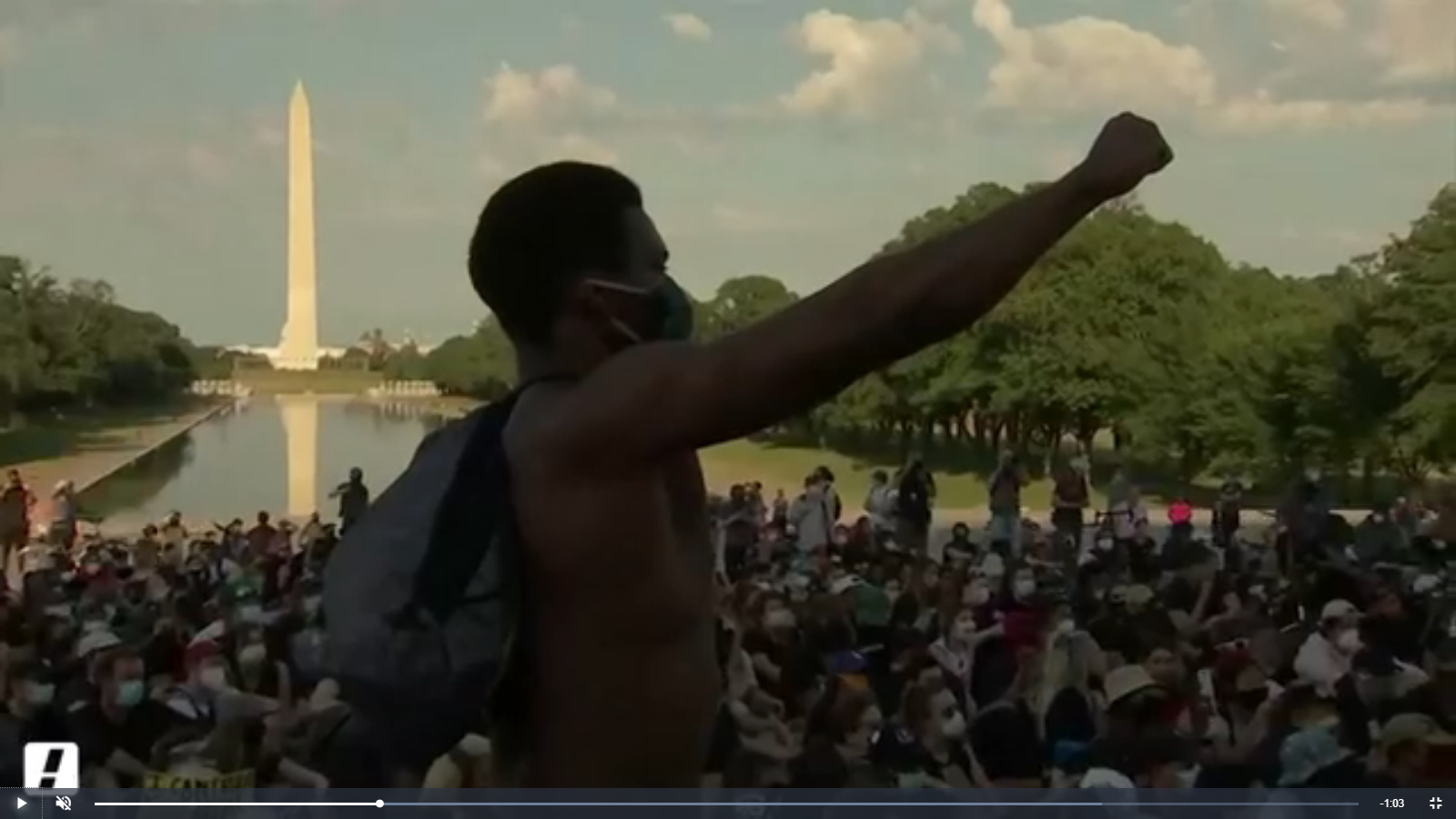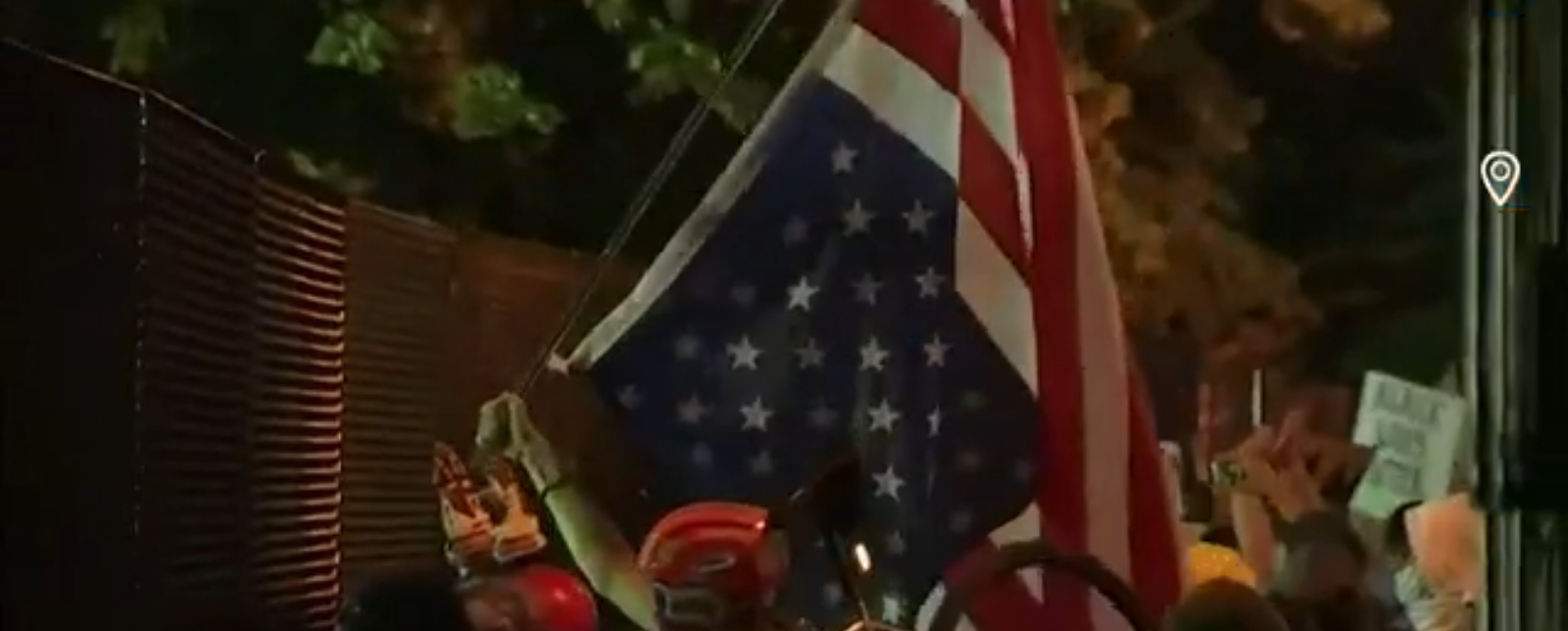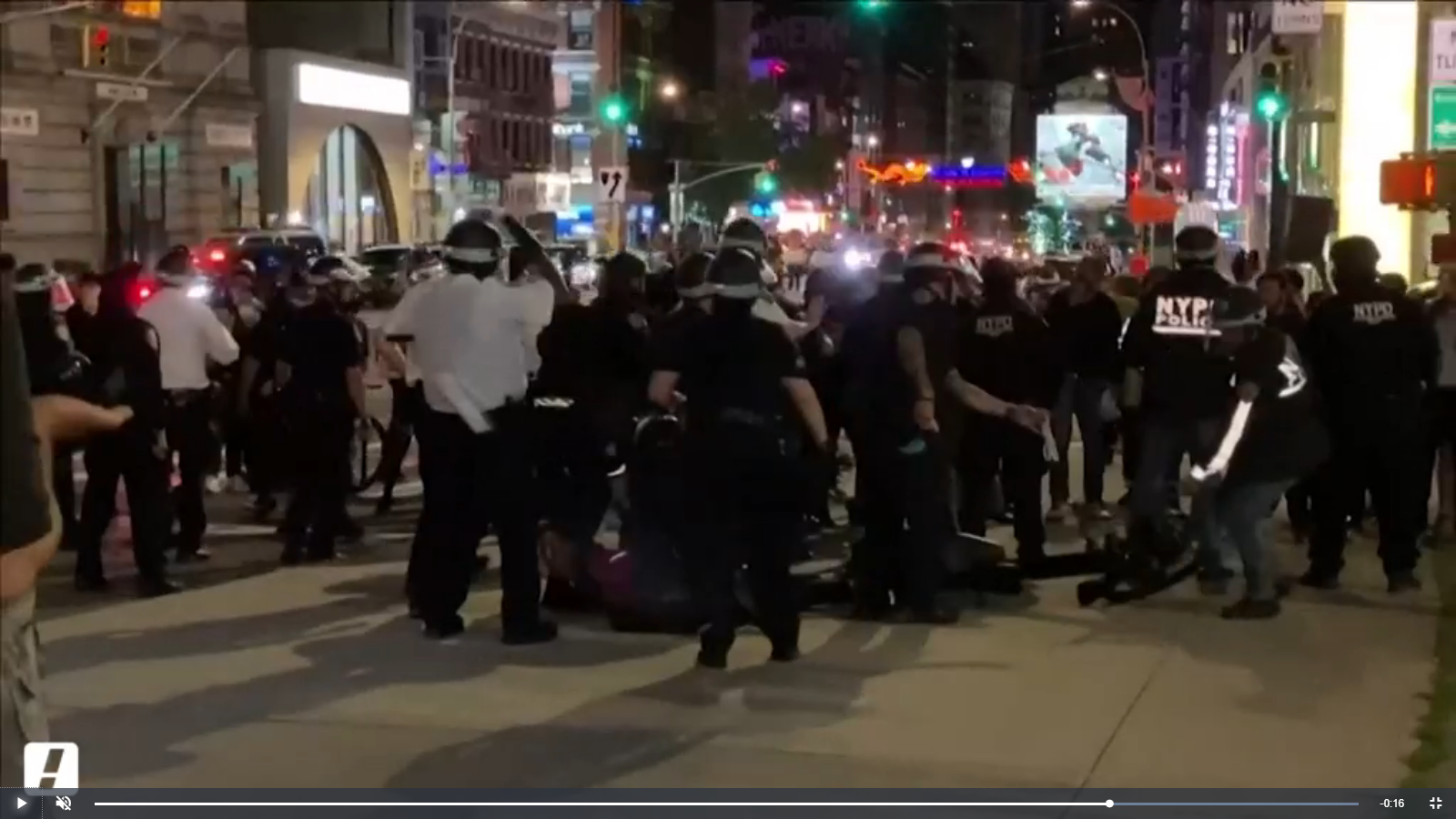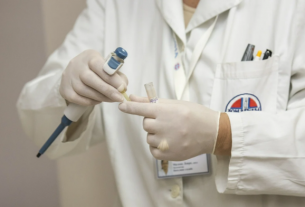Trump sends 1,600 troops to the capital: “They are on alert.” Poll: 64% of Americans support the protest, 55% dissatisfied with the president
Demonstrators continued to march in cities across the U.S. more than a week after the death of George Floyd, a black man who was killed in police custody in Minneapolis. Protesters and police officers were injured as clashes cropped up at night, a shift from the largely peaceful daytime rallies.
Police officers in several cities have been fired or disciplined for their harsh tactics against protesters. In Atlanta, arrest warrants were issued for six officers after video footage showed them firing Tasers and dragging two college students out of a car on Saturday.
One of the big rallies tonight was held in Washington DC, close to the White House – the same place last night demonstrators were evicted with stun grenades, smoke grenades, and cavalry so President Donald Trump could visit a nearby church and pose with a Bible in his hand.
Thousands of protesters gathered tonight near the fences posted at the entrance to Lafayette Park, across from the White House, with many police and soldiers guarding them from entering the park.
The crowd shouted the name of George Floyd, who he allegedly choked to death last week by a white police officer in Minneapolis. The cop stuck his knee to his neck for eight minutes – though Floyd repeatedly pleaded that he couldn’t breathe.
Protesters also gathered in front of St. John’s Church, the same church that Trump visited the night before. On the asphalt near the church, protesters wrote slogans like Black Lives Matter, but with erasable chalk rather than a spray. Outside the church stood some priests who prayed with the protesters and handed them bottles of water.
One demonstrator who climbed a traffic light and dropped a traffic sign screamed. “That’s not why we’re here,” said one of the protesters. The nightly curfew in the capital came into effect at 8pm, and at this time many began to leave, but hundreds remained.
In the shadow of a quiet protest in Washington, DC tonight, the Pentagon announced it had moved 1,600 troops into the area. The Pentagon said soldiers moved to bases in the capital are on “increased alert,” but have not deployed in the city of Washington itself. The forces, it said, “do not participate in supporting the actions of the civil authorities” in the city. The transfer of powers to the area comes after Trump’s threat yesterday to send military forces to cities to “control the streets.”
It should be emphasized that under US law, regular military forces (not National Guard forces) cannot assist law enforcement activities within the United States unless the President applies an old 1807 law that allows him to use the military to suppress “social disorder”.
Helicopter isn’t moving and neither is the crowd. The show of military force on US streets is like nothing I would have believed if I weren’t here pic.twitter.com/80UnzDNx17
— Katie Hill (@KatieHill4CA) June 2, 2020
An investigation into the military helicopter incident
This morning, it was reported that the National Guard is investigating the actions that led to aircraft being sent to the capital last night, between Monday and Tuesday. These then circled low altitude over buildings and groups of protesters, in what appeared to be an attempt to disperse them.
A Pentagon spokeswoman told CNN that UH-72 helicopters were dispatched to the area to “provide an observation for National Guard forces while performing civil disobedience operations.” Spokesman Chris Mitchell said helicopters were not dispatched to the area to assist in law enforcement operations themselves.
Besides Washington, D.C., a curfew has been imposed in many cities across the U.S. tonight for fear of violent riots. In New York, thousands marched in Manhattan and Brooklyn shouting slogans like “No justice, no silence” and say his name, “George Floyd.” Police patrol with goddesses followed them.
New York Governor Andrew Cuomo criticized city police and Mayor Bill de Blasio last night, claiming they had failed in their mission to keep order. Following the riots the night before, the New York night curfew was preceded from 11pm to 8pm, and will continue throughout the week. But tonight, too, with the curfew taking effect in New York, many protesters remained outside.
“Something has to break, and it’s not going to be us,” said Owen Kutcher, who along with hundreds of others shouted the name of George Floyd outside the Barclays Center in Brooklyn. “We’re here because something has to change,” he added. Thousands of protesters also gathered in front of the “International Hotel” skyscraper near Central Park, and pictures from there appeared to be kneeling.
CNN reported that only 40 protesters had been arrested, much less than the 700 arrested the night before. Several wounded were reported in a shooting incident in Brooklyn, though it is unclear if it was related to the demonstrations.
According to local television channel WABC, a suspect opened fire on at least one person and was shot dead by police responding to the shooting. Two police officers were reportedly slightly injured.
LOS ANGELES: Mayor and senior police officer kneeled
Protesters gathered in large numbers in Los Angeles and violated the curfew there. Mayor Eric Garstie and senior police officer Cory Falke were spotted joining protesters and kneeling.
A huge march was held in Houston, Texas and, according to protest organizers, 60,000 people attended. Houston is the city where George Floyd was born, where he lived most of his life before moving to Minneapolis, Minnesota, where he found his death. His body is expected to be buried in Houston next week. Several members of his family gathered tonight on the steps of the Town Hall, from where the march began, and thanked the protesters. His brother, Terrence, urged them to avoid violence. Addressing those who rioted in earlier protests, he said: “You are shaming the names of us all, not just your name.”
At some points, the protests did deteriorate into violence. According to authorities in Charlotte, North Carolina, a small group of protesters threw bottles, fireworks and some “chemical” at the cops. “Violence escalates and puts police officers in danger,” local police said. The police responded with tear gas fire and other means of dispersing demonstrations.
Tonight, Floyd’s 6-year-old daughter, Gianna, also posed in front of the cameras with her mother calling for justice for the girl’s father. The mother, Roxy Washington, burst into tears, saying she wanted the world to know that her daughter had lost a good father who would never get to see his daughter grow up. “I want everyone to know that this is what these police officers took. At the end of the day, they can go home to their families,” the mother said at a news conference in Minneapolis. “Gianna has no father. He will never see her grow up, get a degree. He will never see her get married,” she added. “I’m here for my sweet girl and I’m here for George, because I want justice for him. I want justice for him because he was good. No matter what people think, he was good.”
Knee on the neck: 58 lost recognition in 2012 from Minneapolis
Floyd’s family members, as well as protesters, demand that Minnesota authorities charged with murder not only Officer Derek Chauvin who was documented tying his knee to Floyd’s neck, but also the other three police officers involved in his arrest. Two of them helped captivate Floyd to the ground, after he was arrested on suspicion of using a $20 counterfeit bill in a convenience store, and another trooper stood aside and did nothing despite Floyd’s pleas. The family is also demanding to aggravate the charge against Chauvin, from third-degree murder to first-degree murder.
Floyd’s little daughter, Gianna, was carrying by basketball past American Steven Jackson. “Why do we have to see her suffer? I’m here to do justice to my brother … and somehow, for heaven’s sake, we’re going to get him,” Jackson said. “It has to stop,” he added, referring to the African American community’s allegations of police violence and systematic racism directed against them.
In that regard, it should be noted, Minnesota authorities today announced an investigation into how the Minneapolis police, the city where Floyd was killed during his arrest, is enforcing civil rights. Governor Tim Waltz said he and Minnesota Human Rights Commissioner Rebecca Losero agreed the investigation would try to identify short-term measures to address racial discrimination in the Minneapolis Police Department as well as long-term solutions to bring about systemic change.
“We know that deep problems exist,” the governor said at a news conference last night. “The reason I know this is because we saw the casual way in which George Floyd’s life and humanity were erased. We also saw the community’s reaction. They expected nothing to happen, because nothing really happened so many times in the past.”
Waltz added that the investigation will also examine the procedures and practices that Minneapolis police officers have implemented over the past decade. His message comes as reports in the background that Chauvin’s method of grounding Floyd – attaching a knee to his neck – has led in recent years to dozens of detainees losing consciousness.
According to a CNN analysis of police data in Minneapolis, since 2012, this detention method has been operated on the necks of 428 people. 58 of them, 14%, lost consciousness. According to the U.S. News Network, these numbers mean that almost every week, Minneapolis police officers use a method that is banned in many cities and states across the U.S. According to the data, about one-third of those so grounded were black, in a city where the African-American community accounts for only 19% of the population .
CNN noted that although city procedures allow police to put pressure on the neck of detainees by hand or leg, they prohibit direct pressure on the airways. Legal experts have indicated to the network that police officers violated the procedures, as Floyd shouted again and again that he could not breathe. Officer Chaubin, recalls, continued to pin his neck to his neck a few minutes after he stopped responding.
The political risk that Trump is taking
The turbulent protest in the US, which has seen unprecedented riots and riots since the 1968 protests following the murder of Martin Luther King, comes in the background of the upcoming presidential election on Nov. 3. Biden, past President Trump, according to a poll conducted by the Ipsus Institute, 47 percent of respondents said they were planning to vote for Biden, compared to 37 percent who said they would vote for Trump.
Last night, Biden made a special speech following the George Floyd riots in which he accused Trump of “hating the fire of hate.” In a speech in Philadelphia, one of the cities that have been witnessing violent protests in recent days, Biden tried to emphasize that he is the perfect opposite of the Republican president. He vowed to work toward merging the interracial rift in the US, arguing that Trump is “dazzled by his ego.” “The president is now part of the problem and he is increasing it,” he said.
Another poll released by Reuters points to widespread American public support for the protest that erupted following Floyd’s death. Sixty-four percent of respondents said they felt “sympathy” for those who were demonstrating these days, while 27% said no and 9% said they were unsure.
The poll points to the political risk in the tough, militant line Trump has taken around the protests and riots. Trump called the actions of protesters, who at times became riot and looting, “domestic terrorist acts”, called on governors to “control the streets” – and threatened to send the military to cities that refuse to use National Guard soldiers to keep order.
According to a Reuters and Ipsos poll, 55 percent of Americans feel dissatisfied with Trump’s conduct regarding the protest. Only a third expressed support, less than even the overall Trump support rate according to the poll, 39%.
In the poll, both Democrats and Republicans answered that they support nonviolent protests and that they believe property damage is undermining protests. The American suburbs also strongly support the protest, according to the survey, and more than half of those in the periphery say they support nonviolent protest, while 7 out of 10 respondents who live in the cities expressed support.
Read more about: Protests in the US









